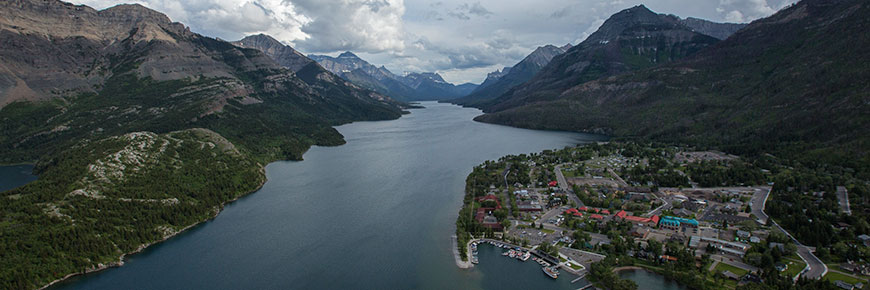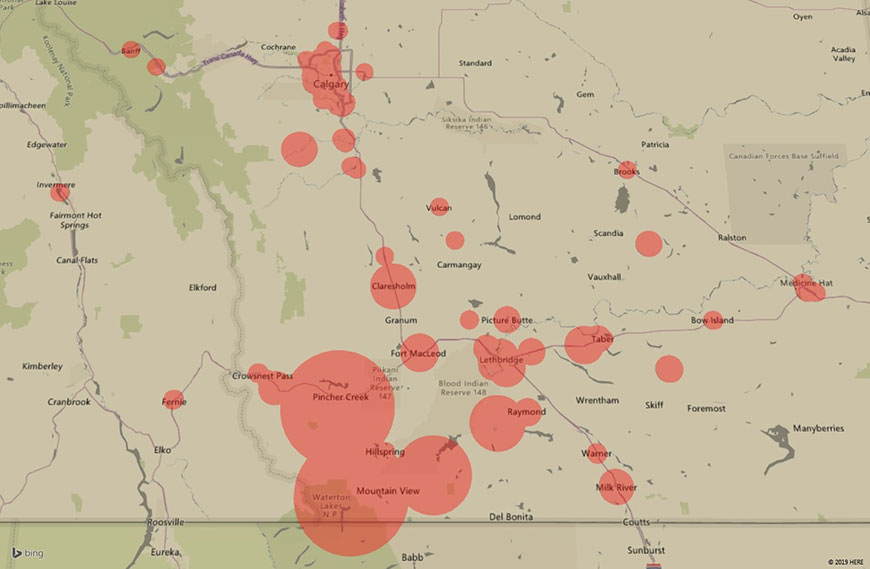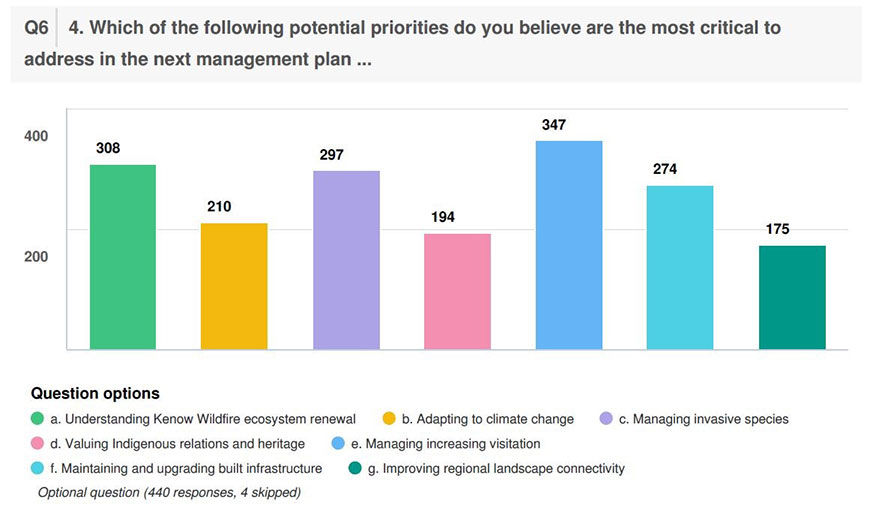
What we heard: Summary of public and Indigenous community comments on the Management Plan review
Waterton Lakes National Park
Download the PDF version (436 KB)
Acknowledgement
Waterton Lakes National Park would like to thank all those who participated and who encouraged participation by promoting the online platform within their respective networks and newsletters. Overall, the breadth of comments received demonstrate that people care passionately about Waterton Lakes National Park and wish to ensure that this special place continues to be protected for future generations.
The engagement process
Parks Canada is committed to providing engagement and consultation opportunities to Canadians throughout the management planning process. This includes meaningful opportunities for Indigenous peoples, stakeholders, youth and the public to contribute to the Waterton Lakes National Park 2020 Management Plan.
The first phase of engagement and consultation sought feedback on the long-term vision of the park and priorities to address over the next decade. This phase took place through in-person engagement sessions and online feedback between April 10 and July 3, 2019. This feedback will be considered as a draft management plan is developed. The next phase of engagement and consultations will occur in winter 2020. At that time, there will be an opportunity to review and comment on the draft management plan.
Summary of engagement activities
Waterton Lakes National Park reached out to Indigenous peoples, local and regional communities, regional stakeholders, youth, Parks Canada staff and other interested Canadians through a range of engagement opportunities to gather initial feedback in the park management planning process. We gave participants an overview of the 2019 State of the Park Assessment and shared potential issues and priorities as starting points for discussion.
Engagement activities included an open house, a stakeholder workshop, and a youth workshop in WLNP, as well as outreach at local festivals and regional events. The goal was to highlight engagement opportunities and collect feedback from participants on key questions.
Parks Canada is committed to reconciliation and renewed relationships with Indigenous peoples, based on a recognition of rights, respect, co-operation and partnership. Treaty 7 nations (Káínai, Piikáni, Siksiká, Stoney-Nakoda, Tsuut’ina) as well as Aamsskáápipikani (Blackfeet, Montana U.S.A), Ktuanaxa Nation and the Métis Nation of Alberta were invited to indicate their preferred approach to engagement in the management planning process, their vision for the long-term future of the park and their recommended priorities in the management plan. Discussions are ongoing with Indigenous Nations and community representatives to ensure their perspectives are heard and shape the development of the draft management plan. Comments below reflect what has been heard so far and may evolve as additional input is received in the coming months.
An online platform called Let’s Talk Mountain Parks was created with the other mountain national parks, enabling interested Canadians to be part of the discussion. Postcards, social media posts, emailed bulletins and a media pitch were used to raise awareness of the engagement opportunities.
This report summarizes what we heard online and in person.
Appendix 1 provides examples of direct quotes received by participants on key themes.
Who we heard from
Face-to-face discussions
Over 150 people attended 12 engagement events or interacted with staff to provide input on the desired future of Waterton Lakes National Park.
Participants to the Stakeholder Workshop included regional and provincial governments, environmental and philanthropic organizations, outdoor recreation interest groups, local community representatives, destination marketing organizations and local business operators.
Parks Canada staff met separately with Indigenous government officials, members of Indigenous communities and the Glacier National Park, U.S.A. management team. Kiosks to raise awareness on the management planning process and to collect input were set up at the Kainai Ecosystem Protection Association 2019 Summit, Lethbridge University Earth Day Symposium and Mountain Equipment Co-op in Calgary.
Online comments
The Waterton Lakes National Park Let’s Talk Mountain Parks website received 2,497 unique visits during the three-month engagement period. 745 people proceeded to view various sections of the website or downloaded background planning documents, such the State of the Park Assessment report.
443 people completed online surveys. The demographic profiles were:
- 25% of respondents were 18-34 years old; 60% were 35-64 years old; 15% were over 64 years old.
- 64% had visited WLNP more than 40 times; 24% between 10-40 times.
- 80% last visited the park after the September 2017 Kenow Wildfire.
- 90% of respondents were from Alberta.
As illustrated by the map below, the pink highlighted areas indicate that a large proportion of online respondents were from southern Alberta.

What we heard from Indigenous communities
Comments below reflect what has been heard so far from Indigenous Nations and community members, and may evolve as additional input is received in the coming months.
Vision elements
We heard that protecting nature should be the highest priority for Waterton Lakes National Park, echoing a cornerstone of Parks Canada’s mandate. Indigenous partners expressed that increasing recognition and value of the Indigenous heritage, worldview and knowledge of the area would contribute to achieving this goal. Other elements brought forward for the vision of the park included:
- WLNP should be an area where nature and culture are alive and treasured, enabling experiences of connection to the land, spirituality and ceremony;
- Valuing and profiling Indigenous knowledge and connection to the region, would strengthen appreciation and understanding of the area for all visitors;
- Focus of visitation should be on experiencing, connecting to and learning about nature, including the place of humans in the web of life and our responsibility to take care of it.
Key issues
Some clear themes to guide the development of the draft management plan emerged from Indigenous input:
Indigenous presence
- The importance of the region for Indigenous peoples, both in past and present, should be better reflected and made more visible (e.g. through interpreted archeological sites, additional signs and other visitor opportunities).
- The use of traditional Blackfoot place names, will enable everyone to better connect with, and honour, the longstanding Indigenous relationship with the land.
- Employment opportunities and partnerships with Indigenous organizations should be facilitated by Parks Canada.
Protected cultural landscape
- WLNP must enhance its role as a learning place about the interconnectedness of nature and culture through Blackfoot knowledge and world views.
- The International Peace Park designation is an appropriate reflection of the region’s past and present use as a zone of cooperation between various peoples based on the area’s bountiful nature. Its special status as a focal point for Indigenous spirituality, gathering medicines, hunting and ceremony should be celebrated and further pursued.
- Visitors to WLNP should be expected to behave in a respectful and appropriate manner similarly to ‘codes of conduct’ and protocols that are in place for sacred places and important events.
Access
- Accessibility to the park for Indigenous Peoples, particularly to specific areas of spiritual and cultural importance, should be prioritized.
- Indigenous visitors should feel welcomed and at home in the park.
Indigenous knowledge
- WLNP has a role to play in facilitating knowledge transfer across generations and supporting Indigenous peoples’ reconnection to traditional territories and land-based knowledge.
- Showcase the ingenuity of Indigenous knowledge, especially human health and sustenance about the land in collaboration with knowledge keepers and partners.
Park management
- Indigenous partners want to be involved in park management, including planning, delivering projects, monitoring and evaluation, through a permanent mechanism based on a solid relationships and meaningful two-way exchange.
- Allow ample time to consult Indigenous governments and organizations and develop strong relationships based on trust.
What we heard from the public and stakeholders
The following section outlines some of the main themes that emerged during the engagement period concerning the park vision and potential priorities for the next ten years.
Vision elements
Canadians were asked about their vision for Waterton Lakes National Park in 15 to 20 years. The most common responses were:
- The wilderness, unique natural beauty, intact ecosystems and biodiversity are protected.
- Development is limited to maintain the intimate, peaceful and rustic character of the park, including its townsite.
- The park is accessible to visitors of various profiles and needs. There are opportunities to enjoy and connect to the area through a diversity of low impact activities.
- Visits to the park provide opportunities for learning and discovery, and encourage respectful, positive behaviours. Doing so allows for enhanced appreciation for the park’s ecological and cultural significance while promoting coexistence, both with wildlife and among cultures.
- The successful protection of ecosystems and management of visitation rely on close collaboration and open communications with partners and stakeholders, particularly at the regional scale.
Key themes and recommended priorities
The online survey asked participants which of the following potential priorities were most important to address in the next decade: understanding Kenow Wildfire ecosystem renewal; adapting to climate change; managing invasive species; valuing Indigenous relations and heritage; managing increasing visitation; maintaining and upgrading built infrastructure; and improving regional landscape connectivity. As illustrated by the graph below, each of these potential priorities received significant support.

Graph 1. Compiled online responses on critical priorities to address in next management plan. Respondents could choose as many responses as they viewed appropriate.
Q6. Which of the following potential priorities do you believe are the most critical to address in the next management plan?
Question options:
- a. Understanding Kenow Wildfire ecosystem renewal 308
- b. Adapting to climate change 210
- c. Managing invasive species 297
- d. Valuing Indigenous relations and heritage 194
- e. Managing increasing visitation 347
- f. Maintaining and upgrading built infrastructure 274
- g. Improving regional landscape connectivity 175
- Optional question (440 responses, 4 skipped)
Comments received suggested that it is important to address issues more broadly. The following key themes emerged: healthy ecosystems/ecological integrity; visitation management; accessibility, facilities and infrastructure; Indigenous relations and heritage; visitor stewardship and education; communications, knowledge sharing and public engagement; and regional connectivity and relationships.
Healthy ecosystems/ecological integrity
Canadians told us the wilderness, intact and diverse ecosystems, abundant wildlife, clean air and majestic landscapes are at the core of their deep appreciation for WLNP. We heard that ecosystem management should involve:
- Compatible and consistent management goals, policies, initiatives, monitoring, assessments and funding opportunities with neighbouring protected areas to form a landscape-level conservation approach.
- Proactive measures and targeted public communications that minimize visitors’ ecological footprints and disturbance to wildlife (e.g. availability and awareness of inspection/cleaning stations to prevent aquatic and terrestrial invasive species, backcountry food storage areas, maintenance of effective wildlife corridors, etc.).
- The many impacts of the Kenow Wildfire are monitored and communicated to a variety of audiences, while supporting visitors to personally connect to the area and discover these changes on their own.
- Understanding, monitoring and responding to the impacts of climate change, including reducing the parks carbon footprint, implementing adaptation and resiliency solutions and communicating climate change projection models and plans.
Visitation management
A majority of respondents value the unique character, minimal commercialization and lower visitation numbers in WLNP when compared to other mountain parks. We heard:
- The priorities for visitation should be to intimately experience nature and connect to this special place. It should align with the overall priority of protecting ecosystems.
- Impose limits on infrastructure development and on visitation numbers during high season to ensure quality experiences for visitors by maintaining the park’s quaint and calm character.
- Preserve the sense of place and “small town feel” of the townsite by favouring small and local businesses, ensuring green spaces, and strategically planning for traffic, especially considering the location of the new Visitor Centre.
- Set and communicate clear expectations for visitors prior to their visit (‘park protocol’), and elevate learning opportunities for positive stewardship behaviour.
- Support visitor planning based on interests, with enhanced focus on the shoulder and winter seasons.
- Manage visitation as a region, working with partners and neighbours, especially other protected areas, to offer complementary services and visitor offer.
Accessibility, facilities and infrastructure
We heard numerous comments on reopening access to areas of the park which were closed due to the Kenow Wildfire. While some people wish to see the park’s visitor experience restored to what it was prior to the wildfire, others encouraged the park to use the opportunity to envision changes such as:
- Reduce dependency of cars, particularly in the townsite and on parkways.
- Keep some areas closed to allow for post-fire ecological recovery, limit infrastructure to avoid ecological impact and maintain the small feel of the park.
- Increase and modernize infrastructure such as campsites, parking and day-use areas.
Other keys areas to improve include:
- Facilitate access by providing more shared transportation and shuttle options, both to and within the park.
- Favour assets and operations in the park that are low maintenance, are climate resilient and have low ecological and aesthetic footprints (e.g. introducing a composting program).
- Encourage and respect mixed-use of low impact activities and trail options (e.g. hiking, biking, horseback riding and skiing) to respond to a variety of visitor profiles, changing demographics (e.g. urban visitors, aging population and young families) and ability levels.
- Keep backcountry infrastructure and services minimal (e.g. no electricity), targeting avid and self-sufficient outdoors enthusiasts. Build on existing potential to enhance mountain biking and cross-country experiences.
- Limit commercial developments, ensure affordable options for basic visitor needs (accommodation, food, picnic areas, etc.).
Indigenous relations and heritage
Participants highlighted the importance of increasing awareness and appreciation of Indigenous heritage to accurately communicate histories in the park by:
- Facilitating the sharing of Indigenous stories through Indigenous voices.
- Restoring traditional Blackfoot place names and language, and including them on signs and maps.
- Increasing collaboration opportunities with Indigenous peoples to protect ecological and cultural resources.
- Ensuring meaningful participation of Indigenous partners in park management and consider the use of traditional knowledge in decision making.
Visitor stewardship and education
Participants encouraged instilling visitors with understanding and appreciation of the exceptional natural and cultural history of the area so they adopt respectful behaviours and lessen impact on the park’s ecology and local cultures. Within this theme, key recommendations include:
- Share stories about Waterton’s natural and cultural history, in a variety of interactive approaches and with partners to amplify key messages.
- Create opportunities to raise awareness on the value of protected areas.
- Support youth programming to inspire future park stewards and foster the mental and physical health benefits of spending time in nature. This includes opportunities such as Canyon Youth Camp, partnerships with schools and post-secondary institutions.
- Enhance public presence of PCA staff and interactions with park visitors to explain and encourage appropriate behaviour and attitudes through conversations.
- Enforce fines for inappropriate behaviour, such as approaching wildlife too closely and littering.
- Provide opportunities to understand and witness Kenow Wildfire ecological renewal firsthand.
Communications, knowledge sharing and public engagement
We heard recommendations relating to communication, transparency and engagement opportunities for matters of public interest, including:
- Manage visitor expectations by clearly communicating available activities and ensuring information is easily accessible online and in the park.
- Regular, meaningful consultation and two-way knowledge-sharing opportunities with park users, stakeholders and local communities (including youth).
- Research aligns with park priorities, influences decision-making and findings are shared with the public, particularly concerning Kenow Wildfire renewal.
- Improve public trust through transparency of Parks Canada decision-making basis, plans and conveying how public feedback influences decisions.
- Maximize citizen science and volunteer opportunities to support park priorities, including post-wildfire related activities.
Regional connectivity and relationships
Across all themes, we heard that enhanced cross-boundary collaboration and relationship building with stakeholders and neighbours is an important component to preserving ecological integrity, offering quality visitor experiences and fostering the next generation of park stewards. As part of a greater ecological and cultural landscape, we heard that we should:
- Work closely with neighbouring protected areas, land managers, Indigenous partners and local and regional stakeholders to align goals, plan cooperatively, develop joint initiatives and collaborate on research and monitoring.
- Think beyond park boundaries to support ecosystem health in the Crown of the Continent region, restore threatened aquatic species and protect regional habitat and wildlife corridors for wide-ranging species like grizzly bears and elk.
- Seek guidance from Glacier National Park and act as an International Peace Park model by learning from each other (e.g. response following wildfires, providing outstanding visitor experiences, etc.).
- Collaborate with local and regional businesses and tourism organizations to amplify common public messaging, build on the history and sense of place of the region, share product offers and promote responsible behaviour, such as reducing wildlife attractants and spread of invasive species and respecting sensitive habitats.
- Favour collaboration with neighbouring local and regional governments to plan and deliver operations by sharing services, infrastructure, emergency preparedness, climate change resiliency, and ecological restoration.
Other areas of interest
We received many comments on current operations including opening/closing of facilities, trails, and location of the new Visitor Center, among others. These comments fall outside the scope of long range management planning, however, these operational comments are being compiled to share with Parks Canada staff in WLNP.
More information
Related links
- Date modified :